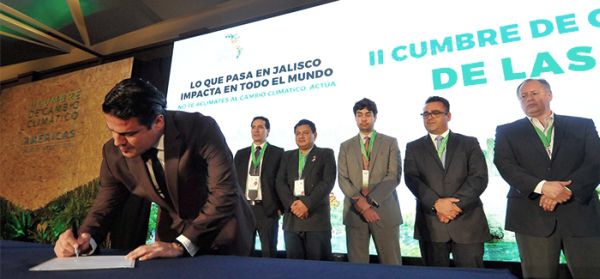Guadalajara, Jalisco, Mexico - Governors, ministers, business and community leaders from across the Americas, and the world, convened last month in Jalisco, Mexico for the 2nd Climate Summit of the Americas.
One year after the first star-studded summit was held in Ontario, Canada, state and provincial governments reunited to showcase their achievements; highlight further challenges; and push further action and cooperation by states and provinces, as well as national governments.
So-called "subnational" governments have been far more visible on the international stage of global climate action in recent years, particularly in the run-up to the United Nations climate negotiations in Paris.
In 2015, California's "Under 2 MOU" brought together a total of 135 states, provinces, and regions - representing one quarter of the world economy - to commit to reducing greenhouse gas emissions by at least 80 percent below 1990 levels by 2050.
While the Americas Summit's purpose is to highlight subnationals, Mexican federal officials, from the newly-named UN climate chief, Patricia Espinosa, to the federal Secretary of Environment and high-ranking energy officials, were there to demonstrate, once again, that Mexico takes its climate reputation very seriously.
Mexico has long been viewed as a climate leader on the international stage.
In 2010, as the host of the global climate negotiations in Cancun, Mexico's diplomats were lauded for pushing climate talks to break the deadlock from the 2009 Copenhagen meeting. In 2012, Mexico passed landmark federal climate change legislation. And in the run-up to the Paris meeting, when building momentum through country pledges was critical to the negotiations' success, Mexico was the first among developing economies (and only the fourth country in the world) to formally pledge to cut its emissions.
Mexico's global climate commitments are intertwined with its landmark national energy overhaul.
Currently the energy sector produces roughly 65% of its total greenhouse gas emissions. Building out these sectors anew after decades of federal monopoly is no small task, but one on which the country has forged ahead, also setting ambitious clean energy goals, such as a goal to source 50% of electricity from clean energy by 2025, reducing methane emissions from oil and gas by 40-45% by 2025, and aiming to set up a clean energy certificates market that will begin operating in 2018.
Bringing these pieces together with its UN targets requires a comprehensive plan that will ultimately ensure the emissions reductions achieved and drive low carbon economic growth.
Such a plan should enable Mexico to align its climate, energy, and economic development objectives – and though a suite of policies are necessary, the country has waded into discussions of a key policy tool that some of the subnational stars of the summit know quite a lot about – capping emissions and putting a price on carbon.
Mexico now has cooperation agreements with California and Quebec, which together operate the second largest emissions trading system in the world.
At the Summit, Mexican federal officials signed a joint agreement with Quebec and Ontario to work toward carbon pricing. The California agreement, signed in 2014, highlights carbon pricing and the implementation of market mechanisms for reducing emissions. The agreement with Quebec and Ontario, signed at the summit on Wednesday, envisions an eventual participation by Mexico in the Western Climate Initiative.
Mexico is aligning its opportunities.
Trade-relationships, and other ties in the Americas are distinct advantages for Mexico in a global carbon trading world. This enviable strategic advantage needs the sustained political will and resources to build a transparent and robust system, and the vision of its policy makers and entrepreneurs to make it work for Mexico.
Original article


